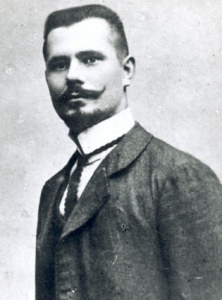The Siege of Sidney Street
A Towering Flame

The Life & Times of ‘Peter the Painter’, By Philip Ruff
SYNOPSIS
The “Houndsditch Murders” of 1910 are still regarded today as the single worst case of police murder in British history. The Latvian anarchists held responsible entered into East London folklore when, trapped inside a house in Stepney, they took on Winston Churchill and the British Army in “The Siege of Sidney Street”. Two died, but no one ever accounted for the mysterious “Peter the Painter”, popularly supposed to be the leader of the gang and to have escaped the burning house during the battle.
The story inspired two major feature films – The Man Who Knew Too Much (Alfred Hitchcock, 1934), and The Siege of Sidney Street (Jimmy Sangster, 1960) – as well as a slew of books, all with different theories on the background to the shootings and the identity of those involved: Peter the Painter was a tsarist police agent, he was Stalin, he was the brother of a Metropolitan Police interpreter, he never existed, he did exist and became an agent of Lenin’s Cheka in Russia. At the start of the 1970s, when the bombing campaign of the Angry Brigade pushed the word “anarchist” back into the headlines, one of the groups under investigation by Special Branch called itself “The Siege of Sidney Street Appreciation Society”. As recently as 2003 one of the contributors to a London Weekend Television documentary about the Houndsditch Murders called Peter the Painter “the Osama Bin Laden of his time”.
It was in that LWT documentary in 2003 that I first put forward evidence to support my identification of Peter the Painter as Janis Zhaklis. I had looked for an answer to the mystery of “Peter the Painter” where no one else (amazingly) had ever thought to look: inside Latvia.
My detective work in Latvia since 1988 has resulted in proof positive of the real identity of “Peter the Painter” (Janis Zhaklis) and unearthed the real story of his life and revolutionary career. But more than that, it has opened a window on the hitherto unknown history of Latvian anarchism and of the 1905 revolution in the Baltic which gave rise to it. This wider story reveals the violent events in London – shocking as they may appear - to be part of a much bigger story of class war, revolution and survival.
The story pieced together in this book is much more than the solution to a simple murder mystery. It places the revolutionary activities of Peter the Painter and the Latvian anarchists in the context of the more than century old struggle of the Latvian people for freedom, against foreign occupation and social injustice. In a world traumatised today by a global “war on terror”, in which Peter the Painter has been likened to Osama Bin Laden, it demonstrates that the actions of the Latvian anarchists in London were not the “terrorism” they have been compared to; but rather part of a resistance movement against the state terrorism of an autocratic Russian government.
The tragic course of modern Latvia’s history – from the 1905 Revolution against German exploitation and a monolithic Russian empire, which denied the existence of a separate Latvian identity; through the first Latvian Republic of 1918-1940; to the triple trial of Soviet-Nazi-Soviet-again occupation, accompanied by state sponsored terror, wartime holocaust, mass deportations to Siberia and an involuntary incorporation into the Soviet Union which only ended in 1991 – are proof enough, if proof is needed, that the struggle of the Latvian anarchists was not without moral foundation; that the will to resist oppression is always present. And for Latvians today, coming to terms with their turbulent past and seeking to find a secure identity for themselves in an uncertain future, perhaps the story of Peter the Painter and the remarkable group of young Latvian anarchists who emerged from the 1905 Revolution may offer an antidote to the national shame voiced by the poet Vizma Belsevica, when she imagined witnessing the unopposed slaughter of the pagan Latvians by German crusaders in the middle ages:
“I want to burn…
To climb towards heaven on a towering flame
And scream out the injustice by which my nation
With fiery iron was beset and slaughtered”
Philip Ruff, London
To read Maira Asare's review of 'A Towering Flame', translated into English